Philip Kotler
- 格式:doc
- 大小:24.00 KB
- 文档页数:1
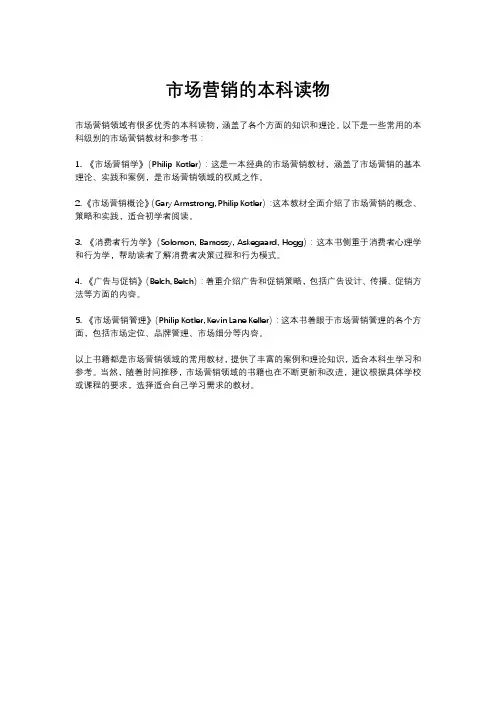
市场营销的本科读物
市场营销领域有很多优秀的本科读物,涵盖了各个方面的知识和理论。
以下是一些常用的本科级别的市场营销教材和参考书:
1. 《市场营销学》(Philip Kotler):这是一本经典的市场营销教材,涵盖了市场营销的基本理论、实践和案例,是市场营销领域的权威之作。
2. 《市场营销概论》(Gary Armstrong, Philip Kotler):这本教材全面介绍了市场营销的概念、策略和实践,适合初学者阅读。
3. 《消费者行为学》(Solomon, Bamossy, Askegaard, Hogg):这本书侧重于消费者心理学和行为学,帮助读者了解消费者决策过程和行为模式。
4. 《广告与促销》(Belch, Belch):着重介绍广告和促销策略,包括广告设计、传播、促销方法等方面的内容。
5. 《市场营销管理》(Philip Kotler, Kevin Lane Keller):这本书着眼于市场营销管理的各个方面,包括市场定位、品牌管理、市场细分等内容。
以上书籍都是市场营销领域的常用教材,提供了丰富的案例和理论知识,适合本科生学习和参考。
当然,随着时间推移,市场营销领域的书籍也在不断更新和改进,建议根据具体学校或课程的要求,选择适合自己学习需求的教材。
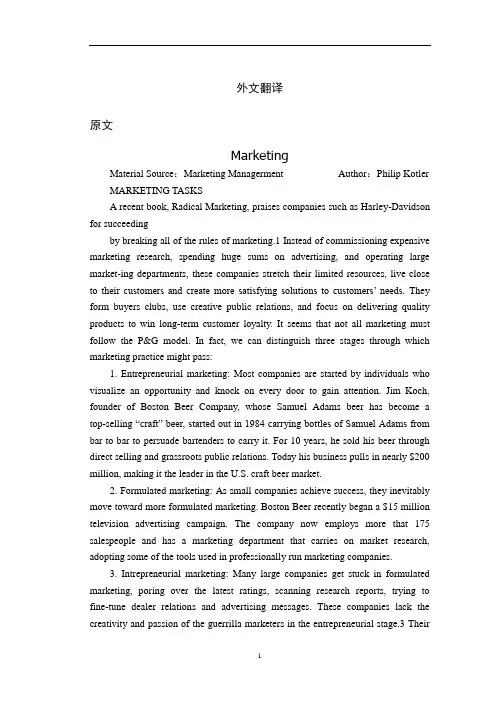
外文翻译原文MarketingMaterial Source:Marketing Managerment Author:Philip Kotler MARKETING TASKSA recent book, Radical Marketing, praises companies such as Harley-Davidson for succeedingby breaking all of the rules of marketing.1 Instead of commissioning expensive marketing research, spending huge sums on advertising, and operating large market-ing departments, these companies stretch their limited resources, live close to their customers and create more satisfying solutions to customers’ needs.They form buyers clubs, use creative public relations, and focus on delivering quality products to win long-term customer loyalty. It seems that not all marketing must follow the P&G model. In fact, we can distinguish three stages through which marketing practice might pass:1. Entrepreneurial marketing: Most companies are started by individuals who visualize an opportunity and knock on every door to gain attention. Jim Koch, founder of Boston Beer Company, whose Samuel Adams beer has become a top-selling “craft” beer, started out in 1984 carrying bottles of Samuel Adams from bar to bar to persuade bartenders to carry it. For 10 years, he sold his beer through direct selling and grassroots public relations. Today his business pulls in nearly $200 million, making it the leader in the U.S. craft beer market.2. Formulated marketing: As small companies achieve success, they inevitably move toward more formulated marketing. Boston Beer recently began a $15 million television advertising campaign. The company now employs more that 175 salespeople and has a marketing department that carries on market research, adopting some of the tools used in professionally run marketing companies.3. Intrepreneurial marketing: Many large companies get stuck in formulated marketing, poring over the latest ratings, scanning research reports, trying to fine-tune dealer relations and advertising messages. These companies lack the creativity and passion of the guerrilla marketers in the entrepreneurial stage.3 Theirbrand and product managers need to start living with their customers and visualizing new ways to add value to their customers’ lives. The bottom line is that effective marketing can take many forms. Although it is easier to learn the formulated side (which will occupy most of our attention in this book), we will also see how creativity and passion can be used by today’s and tomorrow’s marketing managers.Marketing people are involved in marketing 10 types of entities: goods, services, experiences, events, persons, places, properties, organizations, information, and ideas. Goods. Physical goods constitute the bulk of most countries’ production and marketing effort. The United States produces and markets billions of physical goods, from eggs to steel to hair dryers. In developing nations, goods—particularly food, commodities, clothing, and housing—are the mainstay of the economy. Services. As economies advance, a growing proportion of their activities are focused on the production of services. The U.S. economy today consists of a 70–30 services-to-goods mix. Services include airlines, hotels, and maintenance and repair people, as well as professionals such as accountants, lawyers, engineers, and doctors. Many market offerings consist of a variable mix of goods and services.Experiences. By orchestrating several services and goods, one can create, stage, and market experiences. Walt Disney World’s Magic Kingdom is an experience; so is the Hard Rock Cafe. Events. Marketers promote time-based events, such as the Olympics, trade shows, sports events, and artistic performances.Marketing Tasks Persons. Celebrity marketing has become a major business. Artists, musicians, CEOs, physicians, high-profile lawyers and financiers, and other professionals draw help from celebrity marketers. Places. Cities, states, regions, and nations compete to attract tourists, factories, company headquarters, and new residents.5 Place marketers include economic development specialists, real estate agents, commercial banks, local business associations, and advertising and public relations agencies. Properties. Properties are intangible rights of ownership of either real property (real estate) or financial property (stocks and bonds). Properties are bought and sold, and this occasions a marketing effort by real estate agents (for real estate) and investment companies and banks (for securities). Organizations. Organizations actively work to build a strong, favorable image in the mind of their publics. Philips, the Dutch electronics company, advertises with the tag line, “Let’s Make Things Better.” The Body Shop and Ben & Jerry’s also gain attention by promoting social causes. Universities, museums, and performing arts organizations boost their public images to compete more successfully for audiences and funds.Information. The production, packaging, and distribution of information is one of society’s major industries.6 Among the marketers of information are schools and universities; publishers of encyclopedias, nonfiction books, and specialized magazines; makers of CDs; and Internet Web sites. Ideas. Every market offering has a basic idea at its core. In essence, products and services are platforms for delivering some idea or benefit to satisfy a core need.A Broadened View of Marketing TasksMarketers are skilled in stimulating demand for their products. However, this is too limited a view of the tasks that marketers perform. Just as production and logistics professionals are responsible for supply management, marketers are responsible for demand management. They may have to manage negative demand (avoidance of a product), no demand (lack of awareness or interest in a product), latent demand (a strong need that cannot be satisfied by existing products), declining demand (lower demand), irregular demand (demand varying by season, day, or hour), full demand (a satisfying level of demand), overfull demand (more demand than can be handled), or unwholesome demand (demand for unhealthy or dangerous products). To meet the organization’s objectives, marketing managers seek to influence the level, timing, and composition of these various demand states.The Decisions That Marketers MakeMarketing managers face a host of decisions in handling marketing tasks. These range from major decisions such as what product features to design into a new product, how many salespeople to hire, or how much to spend on advertising, to minor decisions such as the wording or color for new packaging. Among the questions that marketers ask (and will be addressed in this text) are: How can we spot and choose the right market segment(s)? How can we differentiate our offering? How should we respond to customers who press for a lower price? How can we compete against lower-cost, lower-price rivals? How far can we go in customizing our offering for each customer? How can we grow our business? How can we build stronger brands? How can we reduce the cost of customer acquisition and keep customers loyal? How can we tell which customers are more important? How can we measure the paybackFrom marketing communications? How can we improve sales-force productivity? How can we manage channel conflict? How can we get other departments to be more customer-oriented?Marketing Concepts and ToolsMarketing boasts a rich array of concepts and tools to help marketers address the decisions they must make. We will start by defining marketing and then describing its major concepts and tools.We can distinguish between a social and a managerial definition for marketing. According to a social definition, marketing is a societal process by which individuals and groups obtain what they need and want through creating, offering, and exchanging products and services of value freely with others.As a managerial definition, marketing has often been described as “the art of selling produ cts.” But Peter Drucker, a leading management theorist, says that “the aim of marketing is to make selling superfluous. The aim of marketing is to know and understand the customer so well that the product or service fits him and sells itself. Ideally, mark eting should result in a customer who is ready to buy.” The American Marketing Association offers this managerial definition:Marketing (management) is the process of planning and executing the conception, pricing, promotion, and distribution of ideas, goods, and services to create exchanges that satisfy individual and organizational goals. Coping with exchange processes—part of this definition—calls for a considerable amount of work and skill. We see marketing management as the art and science of applying core marketing concepts to choose target markets and get, keep, and grow customers through creating, delivering, and communicating superior customer value.Marketing can be further understood by defining the core concepts applied by marketing managers.A marketer can rarely satisfy everyone in a market. Not everyone likes the same soft drink, automobile, college, and movie. Therefore, marketers start with market segmentation. They identify and profile distinct groups of buyers who might prefer or require varying products and marketing mixes. Market segments can be identified by examining demographic, psychographic, and behavioral differences among buyers. The firm then decides which segments present the greatest opportunity—those whose needs the firm can meet in a superior fashion. For each chosen target market, the firm develops a market offering. The offering is positioned in the minds of the target buyers as delivering some central benefit(s). For example, V olvo develops its cars for the target market of buyers for whom automobile safety is a major concern. V olvo, therefore, positions its car as the safest a customer can buy.Traditionally, a “market” was a physical place where buyers and sellersgathered to exchange goods. Now marketers view the sellers as the industry and the buyers as the market. The sellers send goods and services and communications (ads, direct mail, e-mail messages) to the market; in return they receive money and information (attitudes, sales data). An exchange of money for goods and services; the outer loop shows an exchange of information. A global industry is one in which the strategic positions of competitors in major geographic or national markets are fundamentally affected by their overall global positions. Global firms—both large and small—plan, operate, and coordinate their activities and exchanges on a worldwide basis.Today we can distinguish between a marketplace and a marketspace. The marketplace is physical, as when one goes shopping in a store; marketspace is digital, as when one goes shopping on the Internet. E-commerce—business transactions conducted on-line—has many advantages for both consumers and businesses, including convenience, savings, selection, personalization, and information. For example, on-line shopping is so convenient that 30 percent of the orders generated by the Web site of REI, a recreational equipment retailer, is logged from 10 P.M. to 7 A.M., sparing REI the expense of keeping its stores open late or hiring customer service representatives. However, the e-commerce marketspace is also bringing pressure from consumers for lower prices and is threatening intermediaries such as travel agents, stockbrokers, insurance agents, and traditional retailers. To succeed in the on-line marketspace, marketers will need to reorganize and redefine themselves. The metamarket, a concept proposed by Mohan Sawhney, describes a cluster of complementary products and services that are closely related in the minds of consumers but are spread across a diverse set of industries. The automobile metamarket consists of automobile manufacturers, new and used car dealers, financing companies, insurance companies, mechanics, spare parts dealers, service shops, auto magazines, classified auto ads in newspapers, and auto sites on the Internet. Car buyers can get involved in many parts of this metamarket. This has created an opportunity for metamediaries to assist buyers to move seamlessly through these groups. One example is Edmund’s (), a Web site where buyers can find prices for different cars and click to other sites to search for dealers, financing, and accessories. Metamediaries can serve various metamarkets, such as the home ownership market, the parenting and baby care market, and the wedding market.译文营销资料来源:营销管理作者:菲利普·科特勒营销工作最近的一本书,激进营销,称赞接替如哈雷戴维森公司打破了所有的营销规则而不是昂贵的调试市场调研,花费巨额广告,经营大市场,我们将解决以下问题:什么是市场营销的任务?什么是主要的概念和营销工具?什么方向做市场的公司参展?公司如何和营销应对新的挑战呢?营销在二十一世纪,安泰部门,这些公司伸展自己的资源有限,住在靠近他们的客户,创造更令人满意的解决方案,以客户的需求。
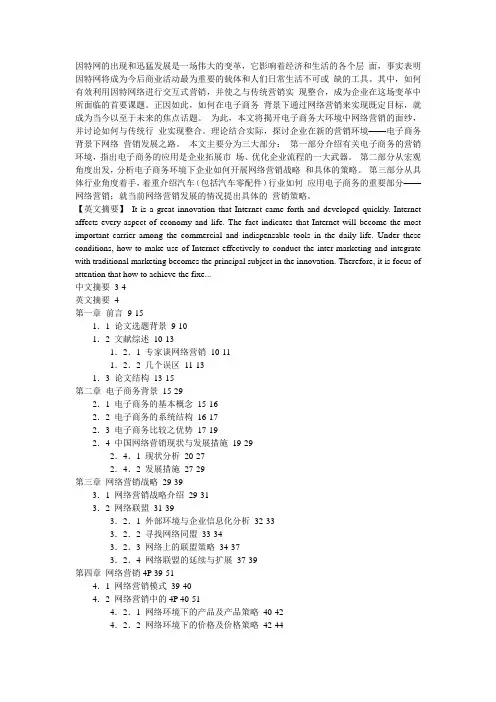
因特网的出现和迅猛发展是一场伟大的变革,它影响着经济和生活的各个层面,事实表明因特网将成为今后商业活动最为重要的载体和人们日常生活不可或缺的工具。
其中,如何有效利用因特网络进行交互式营销,并使之与传统营销实现整合,成为企业在这场变革中所面临的首要课题。
正因如此,如何在电子商务背景下通过网络营销来实现既定目标,就成为当今以至于未来的焦点话题。
为此,本文将揭开电子商务大环境中网络营销的面纱,并讨论如何与传统行业实现整合。
理论结合实际,探讨企业在新的营销环境——电子商务背景下网络营销发展之路。
本文主要分为三大部分:第一部分介绍有关电子商务的营销环境,指出电子商务的应用是企业拓展市场、优化企业流程的一大武器。
第二部分从宏观角度出发,分析电子商务环境下企业如何开展网络营销战略和具体的策略。
第三部分从具体行业角度着手,着重介绍汽车(包括汽车零配件)行业如何应用电子商务的重要部分——网络营销;就当前网络营销发展的情况提出具体的营销策略。
【英文摘要】It is a great innovation that Internet came forth and developed quickly. Internet affects every aspect of economy and life. The fact indicates that Internet will become the most important carrier among the commercial and indispensable tools in the daily life. Under these conditions, how to make use of Internet effectively to conduct the inter-marketing and integrate with traditional marketing becomes the principal subject in the innovation. Therefore, it is focus of attention that how to achieve the fixe...中文摘要3-4英文摘要 4第一章前言9-151.1 论文选题背景9-101.2 文献综述10-131.2.1 专家谈网络营销10-111.2.2 几个误区11-131.3 论文结构13-15第二章电子商务背景15-292.1 电子商务的基本概念15-162.2 电子商务的系统结构16-172.3 电子商务比较之优势17-192.4 中国网络营销现状与发展措施19-292.4.1 现状分析20-272.4.2 发展措施27-29第三章网络营销战略29-393.1 网络营销战略介绍29-313.2 网络联盟31-393.2.1 外部环境与企业信息化分析32-333.2.2 寻找网络同盟33-343.2.3 网络上的联盟策略34-373.2.4 网络联盟的延续与扩展37-39第四章网络营销4P 39-514.1 网络营销模式39-404.2 网络营销中的4P 40-514.2.1 网络环境下的产品及产品策略40-424.2.2 网络环境下的价格及价格策略42-444.2.3 网络环境下的分销渠道及渠道策略44-484.2.4 网络环境下的促销及促销策略48-51第五章网络营销的运作51-685.1 网络营销的对象研究51-545.2 顾客网络的建立54-59案例分析:高露洁网站分析57-595.3 客户关系管理(CRM)59-645.4 通过网络研究竞争对手64-68第六章基于电子商务的汽车网络营销应用68-846.1 汽车网络营销背景资料68-766.1.1 国外汽车网络营销68-726.1.2 国内汽车网络营销现状与问题72-766.2 国内汽车网络营销思路76-84案例分析:汽车行业电子商务追赶疾驰而去的快车81-84结束语84-87参考文献87-90毕业设计(论文)文献综述(包括国内外现状、研究方向、进展情况、存在问题、参考依据等)引言网络营销是近年来各国学术界较为关心的一个话题,关于网络营销的模式和开展问题引起了全球各企业的关注。
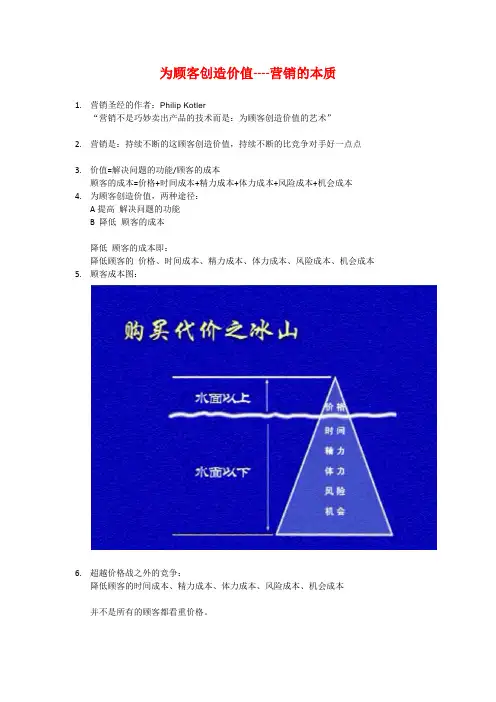
为顾客创造价值----营销的本质1.营销圣经的作者:Philip Kotler“营销不是巧妙卖出产品的技术而是:为顾客创造价值的艺术”2.营销是:持续不断的这顾客创造价值,持续不断的比竞争对手好一点点3.价值=解决问题的功能/顾客的成本顾客的成本=价格+时间成本+精力成本+体力成本+风险成本+机会成本4.为顾客创造价值,两种途径:A提高解决问题的功能B 降低顾客的成本降低顾客的成本即:降低顾客的价格、时间成本、精力成本、体力成本、风险成本、机会成本5.顾客成本图:6.超越价格战之外的竞争:降低顾客的时间成本、精力成本、体力成本、风险成本、机会成本并不是所有的顾客都看重价格。
7.举例:美国西南航空公司:两个城市40分钟的飞行46美元竞争对手降价一半西南航空公司:在目的地顾客凭机票获赠一頩wiski酒原因:两城之间来往的顾客80%是公司出差人员,公司买单。
价格:不是顾客考虑的因素。
济南先锋彩印厂:1000多家彩印厂中价格最高,效益最好李丛发。
顾客:只做农药行业、电信行业农药厂在着急发农药时:需要马上把商标贴在农药瓶上。
时间:是农药厂考虑的因素。
一个商标的价格在一頩农药里可以不以忽略不计。
先锋:可以很快做出产品(商标),价格不降,但大大降低顾客的时间成本。
8.附:菲利普·科特勒(Philip Kotler)博士生于1931年,是现代营销集大成者,被誉为"现代营销学之父",现任西北大学凯洛格管理学院终身教授,是西北大学凯洛格管理学院国际市场学S·C·强生荣誉教授,具有麻省理工大学的博士、哈佛大学博士后、及苏黎世大学等其它8所大学的荣誉博士学位。
现任美国管理科学联合市场营销学会主席,美国市场营销协会理事,营销科学学会托管人,管理分析中心主任,杨克罗维奇咨询委员会成员,哥白尼咨询委员会成员。
9.问题:如果我想做一个:婴儿用品超市。
采取什么营销策略呢?服务:购买的顾客都是妈妈,很少有抱着孩子一起买的,怎么服务?价格:万意百货里有几十家婴儿店,价格都很低,我的价格还能降多少?参考:沃尔玛超市的营销王老吉:口号营销。
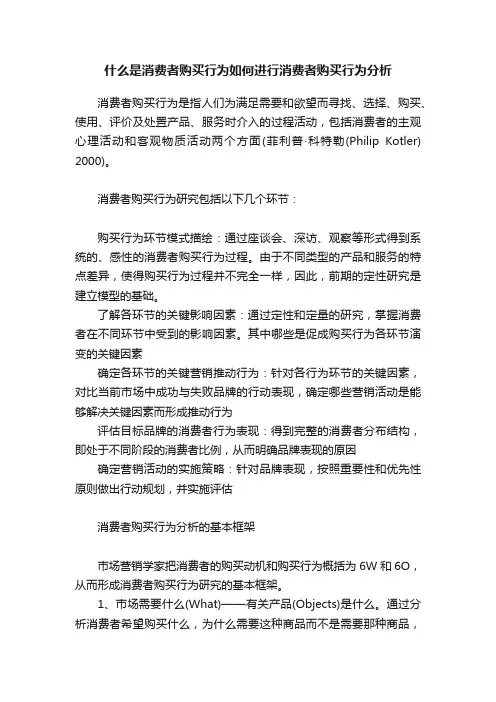
什么是消费者购买行为如何进行消费者购买行为分析消费者购买行为是指人们为满足需要和欲望而寻找、选择、购买、使用、评价及处置产品、服务时介入的过程活动,包括消费者的主观心理活动和客观物质活动两个方面(菲利普·科特勒(Philip Kotler) 2000)。
消费者购买行为研究包括以下几个环节:购买行为环节模式描绘:通过座谈会、深访、观察等形式得到系统的、感性的消费者购买行为过程。
由于不同类型的产品和服务的特点差异,使得购买行为过程并不完全一样,因此,前期的定性研究是建立模型的基础。
了解各环节的关键影响因素:通过定性和定量的研究,掌握消费者在不同环节中受到的影响因素。
其中哪些是促成购买行为各环节演变的关键因素确定各环节的关键营销推动行为:针对各行为环节的关键因素,对比当前市场中成功与失败品牌的行动表现,确定哪些营销活动是能够解决关键因素而形成推动行为评估目标品牌的消费者行为表现:得到完整的消费者分布结构,即处于不同阶段的消费者比例,从而明确品牌表现的原因确定营销活动的实施策略:针对品牌表现,按照重要性和优先性原则做出行动规划,并实施评估消费者购买行为分析的基本框架市场营销学家把消费者的购买动机和购买行为概括为6W和6O,从而形成消费者购买行为研究的基本框架。
1、市场需要什么(What)——有关产品(Objects)是什么。
通过分析消费者希望购买什么,为什么需要这种商品而不是需要那种商品,研究企业应如何提供适销对路的产品去满足消费者的需求。
2、为何购买(Why)——购买目的(Objectives)是什么。
通过分析购买动机的形成(生理的、自然的、经济的、社会的、心理因素的共同作用),了解消费者的购买目的,采取相应的市场策略。
3、购买者是谁(Who)——购买组织(Organizations)是什么。
分析购买者是个人、家庭还是集团,购买的产品供谁使用,谁是购买的决策者、执行者、影响者。
根据分析,组合相应的产品、渠道、定价和促销。
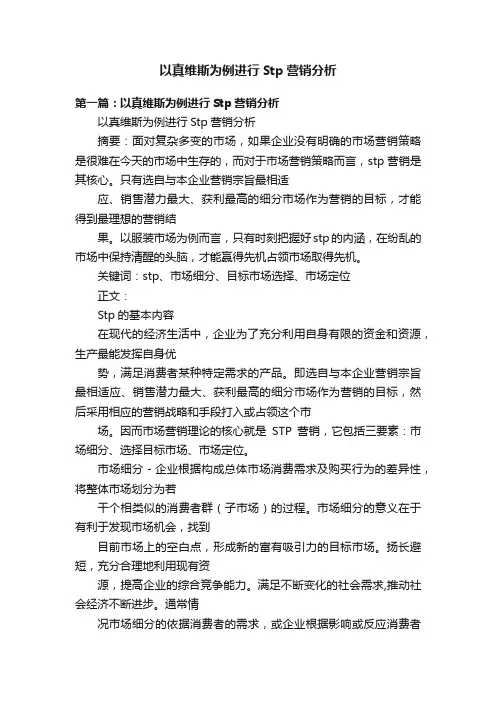
以真维斯为例进行Stp营销分析第一篇:以真维斯为例进行Stp营销分析以真维斯为例进行Stp营销分析摘要:面对复杂多变的市场,如果企业没有明确的市场营销策略是很难在今天的市场中生存的,而对于市场营销策略而言,stp营销是其核心。
只有选自与本企业营销宗旨最相适应、销售潜力最大、获利最高的细分市场作为营销的目标,才能得到最理想的营销结果。
以服装市场为例而言,只有时刻把握好stp的内涵,在纷乱的市场中保持清醒的头脑,才能赢得先机占领市场取得先机。
关键词:stp、市场细分、目标市场选择、市场定位正文:Stp的基本内容在现代的经济生活中,企业为了充分利用自身有限的资金和资源,生产最能发挥自身优势,满足消费者某种特定需求的产品。
即选自与本企业营销宗旨最相适应、销售潜力最大、获利最高的细分市场作为营销的目标,然后采用相应的营销战略和手段打入或占领这个市场。
因而市场营销理论的核心就是STP营销,它包括三要素:市场细分、选择目标市场、市场定位。
市场细分-企业根据构成总体市场消费需求及购买行为的差异性,将整体市场划分为若干个相类似的消费者群(子市场)的过程。
市场细分的意义在于有利于发现市场机会,找到目前市场上的空白点,形成新的富有吸引力的目标市场。
扬长避短,充分合理地利用现有资源,提高企业的综合竞争能力。
满足不断变化的社会需求,推动社会经济不断进步。
通常情况市场细分的依据消费者的需求,或企业根据影响或反应消费者需求等因素对市场进行细分。
这些因素又可以分为两大类:一类是反映消费者特征的因素,如地理因素、人文因素和心理因素;一类是产品的反应情况,如消费者所追求的利益、消费者使用时机、使用频率等。
而通常细分市场遵循着可衡量性、可进入性、可盈利性、可区分性这四个原则。
可衡量性即细分市场必须是能够被识别和衡量,细分市场要有清晰的边界,同时,细分市场的各种市场特征是能识别和表达的。
可进入性即企业所选择的目标市场是否易于进入,根据企业目前的人、财、物和技术等资源条件能否通过适当的营销组合策略占领目标市场。
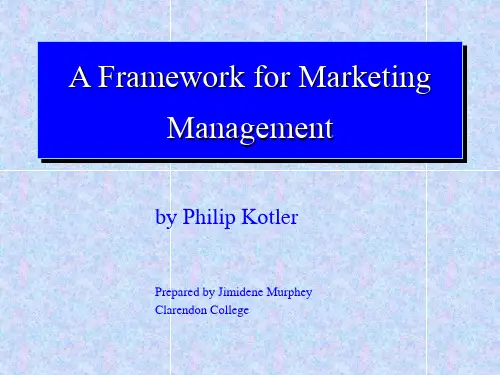
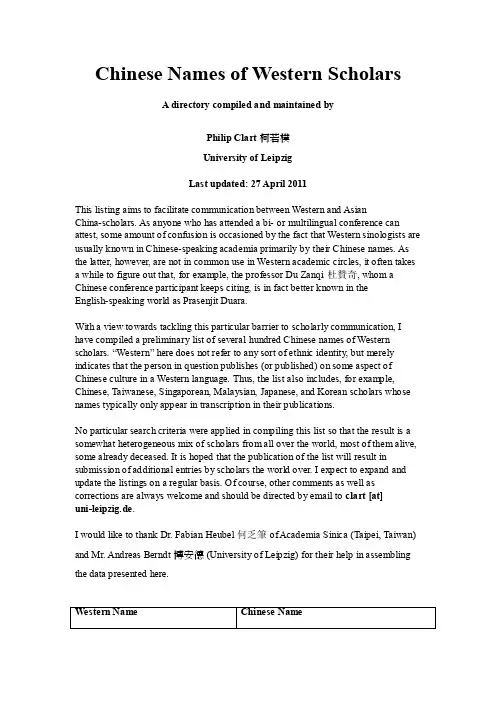
Chinese Names of Western ScholarsA directory compiled and maintained byPhilip Clart 柯若樸University of LeipzigLast updated: 27 April 2011This listing aims to facilitate communication between Western and AsianChina-scholars. As anyone who has attended a bi- or multilingual conference can attest, some amount of confusion is occasioned by the fact that Western sinologists are usually known in Chinese-speaking academia primarily by their Chinese names. As the latter, however, are not in common use in Western academic circles, it often takes a while to figure out that, for example, the professor Du Zanqi 杜贊奇, whom a Chinese conference participant keeps citing, is in fact better known in theEnglish-speaking world as Prasenjit Duara.With a view towards tackling this particular barrier to scholarly communication, I have compiled a preliminary list of several hundred Chinese names of Western scholars. “Western” here does not refer to any sort of ethnic identity, but merely indicates that the person in question publishes (or published) on some aspect of Chinese culture in a Western language. Thus, the list also includes, for example, Chinese, Taiwanese, Singaporean, Malaysian, Japanese, and Korean scholars whose names typically only appear in transcription in their publications.No particular search criteria were applied in compiling this list so that the result is a somewhat heterogeneous mix of scholars from all over the world, most of them alive, some already deceased. It is hoped that the publication of the list will result in submission of additional entries by scholars the world over. I expect to expand and update the listings on a regular basis. Of course, other comments as well as corrections are always welcome and should be directed by email to clart [at]uni-leipzig.de.I would like to thank Dr. Fabian Heubel 何乏筆of Academia Sinica (Taipei, Taiwan) and Mr. Andreas Berndt 博安德 (University of Leipzig) for their help in assembling the data presented here.。

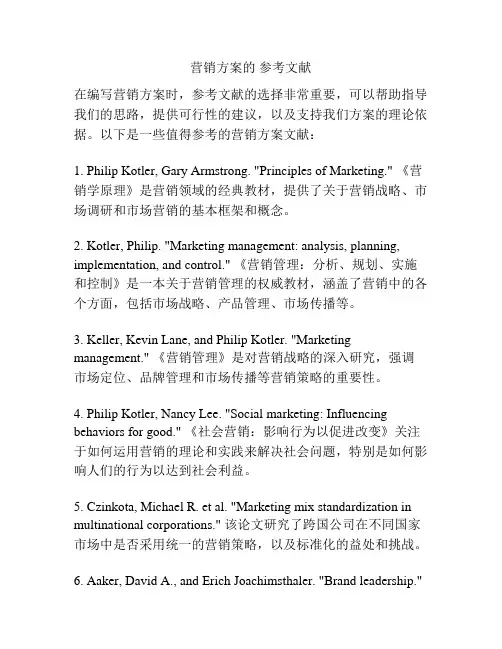
营销方案的参考文献在编写营销方案时,参考文献的选择非常重要,可以帮助指导我们的思路,提供可行性的建议,以及支持我们方案的理论依据。
以下是一些值得参考的营销方案文献:1. Philip Kotler, Gary Armstrong. "Principles of Marketing." 《营销学原理》是营销领域的经典教材,提供了关于营销战略、市场调研和市场营销的基本框架和概念。
2. Kotler, Philip. "Marketing management: analysis, planning, implementation, and control." 《营销管理:分析、规划、实施和控制》是一本关于营销管理的权威教材,涵盖了营销中的各个方面,包括市场战略、产品管理、市场传播等。
3. Keller, Kevin Lane, and Philip Kotler. "Marketing management." 《营销管理》是对营销战略的深入研究,强调市场定位、品牌管理和市场传播等营销策略的重要性。
4. Philip Kotler, Nancy Lee. "Social marketing: Influencing behaviors for good." 《社会营销:影响行为以促进改变》关注于如何运用营销的理论和实践来解决社会问题,特别是如何影响人们的行为以达到社会利益。
5. Czinkota, Michael R. et al. "Marketing mix standardization in multinational corporations." 该论文研究了跨国公司在不同国家市场中是否采用统一的营销策略,以及标准化的益处和挑战。
6. Aaker, David A., and Erich Joachimsthaler. "Brand leadership."《品牌领导力》着重于建立和管理品牌,探讨了如何通过品牌战略来影响消费者行为和品牌忠诚度。
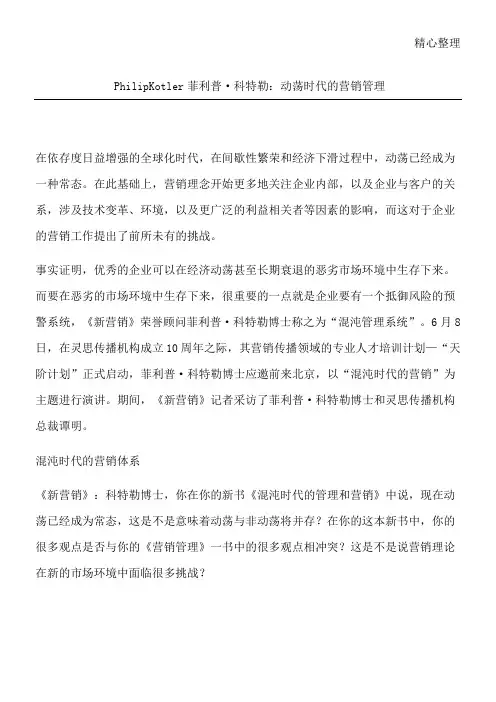
精心整理PhilipKotler菲利普·科特勒:动荡时代的营销管理在依存度日益增强的全球化时代,在间歇性繁荣和经济下滑过程中,动荡已经成为一种常态。
在此基础上,营销理念开始更多地关注企业内部,以及企业与客户的关6月8荡已经成为常态,这是不是意味着动荡与非动荡将并存?在你的这本新书中,你的很多观点是否与你的《营销管理》一书中的很多观点相冲突?这是不是说营销理论在新的市场环境中面临很多挑战?菲利普·科特勒:我认为现在的营销理论和以前的营销理论都是一样的,没有什么变化,只是在不同的情况下营销理论的运用方式会有所不同。
这里“不同的情况”是指出现了经济衰退或者是出现了通货膨胀、经济动荡的时候应该如何运用营销理论。
现在动荡比以往更多,已经成为一种常态。
所以企业一定要做好准备,随时进行变个版则是不断波动。
所以我在《混沌时代的管理和营销》这本书中要教给大家的是,如果出现动荡或者出现不稳定性、出现风险的时候,企业怎么应对。
我的建议是,企业可以采取以下三项措施:第一,建立预警体系;第二,进行情景规划;第三,进行有灵活性的预算。
正式的预警体系指的是,我们对一些主要领域应该进行紧密地观测,如果在这些领域出现动荡的话,到时候你不应该觉得震惊。
举个例子,对于生产电动车电池的企业来说,不仅可以制造出行驶四五十英里不用充电的电池,你还要紧密观测中国、印度企业,它们的要求可能是要行驶100英里不用充电,对此你不要感到惊奇。
对于这样的企业你应该紧密观测,看有没有其他技术人员突然有了一个突破性的发明,应该采取什么样的对策?菲利普·科特勒:对企业来说,最棘手的就是在经济危机的情况下如何应对。
我不愿意看到企业裁减员工、削减营销预算,但我同样不希望企业无所事事,因为现在是采取行动的时候。
当然,我也不愿意看到企业出现恐慌。
这时候对于一个企业来说,应该坐下来和员工一起商量大家今后朝着什么方向前进,大家的愿景是什么,要看一下在5年后大家的愿景能否实现。
白马寺宗教旅游品牌战略的实施洛阳师范学院历史文化学院 张萌摘 要:白马寺的品牌经营,在宗教需求多样化和旅游飞速发展的今天,显得过于片面和缺乏市场,因此,有必要提出一种全新的品牌发展战略,使白马寺宗教旅游产品取得更好的效益。
如何借助旅游品牌来塑造白马寺,让这个千年“祖庭”重现辉煌,提高其在旅游者心中的地位,是本文考虑的重点。
关键词:白马寺 品牌 旅游品牌中图分类号:F590 文献标识码:A 文章编号:1005-5800(2011)01(b)-187-021 白马寺品牌建设的必要性中国佛教资源丰富,但白马寺在中国佛教的地位无可比拟。
1.1 中国佛教的第一古刹白马寺是佛教首传中国后由官方创建的第一座寺院,初建于东汉永平十一年(公元68年),为铭记白马驮经之功,遂将寺院取名“白马寺”,从白马寺始,中国僧院便泛称为寺。
白马寺是佛教界、佛教史界公认的中国第一古刹,自宋代开始便敬称“祖源”,元代又有“释源”、“祖庭”等称呼。
由明、清以及民国碑刻知,“祖庭”的称谓延用至今。
另外,嵌于毗卢阁内后壁刻于大德十一年的《龙川和尚遗嘱记》则呼以“祖刹”。
1.2 中国佛教最主要的译经场所白马寺是中国佛教最主要的译经场所,独具影响力。
截至东汉末年,众多高僧大德在洛阳共译出佛经二百九十二部,三百九十五卷。
随着佛经汉译本的逐渐增多,佛教在我国日益广泛传播开来。
所以尽管后来佛教派系繁多,刹庙林立,但白马寺一直被佛门弟子同尊为中国佛教的发源地。
1.3 中国佛教传于洛阳佛教逐步的发展呈现出了佛教中国化的特点,对中国文化影响重大。
从白马寺开始,佛教开始向中国全境传播,中国历代高僧甚至外国名僧也来此览经求法。
作为中国传统文化重要的组成部分,佛教与佛教文化不但给中国人民的思想和生活带来了重大影响,还逐步传播到越南、北韩半岛和日本。
世界佛教源于印度,我国佛教传于洛阳。
1.4 海内外佛教交流的桥梁白马寺历史上接待过很多海内外政治、宗教团体,重要的来访有:1972年柬埔寨国王西哈努克亲王、1993年印度总理拉奥和2003年印度总理瓦杰帕伊等。
广告营销书籍以下是一些关于广告营销的书籍推荐:1.《营销定位》(Marketing Management)- by Philip Kotler这本书是广告营销的经典著作之一,作者是营销学领域的权威Philip Kotler。
书中详细讲解了市场营销的基本概念、理论和实践,对广告营销有很深入的分析和探讨。
2.《广告传播学》(Advertising and Promotion: An Integrated Marketing Communications Perspective)- by George E. Belch and Michael A. Belch这本书全面介绍了广告传播学的理论和实践,包括广告策略、媒体选择、创意制作等方面内容。
适合初学者和广告从业者阅读。
3.《传播学概论》(Introduction to Mass Communication: Media Literacy and Culture)- by Stanley J. Baran这本书广泛介绍了传播学的基本概念、理论和实践。
对于了解广告营销行业的发展背景和传播学的基本知识有很大帮助。
4.《推销的时髦与艺术》(The Art of Persuasion: Mastering the Selling Process)- by Robert W. Bly这本书介绍了推销和广告营销的基本技巧和策略。
作者通过实例和案例,教授读者如何用有效的方式进行推销和广告。
5.《消费者行为学》(Consumer Behavior)- by Leon G. Schiffman and Leslie Lazar Kanuk这本书深入研究了消费者行为的心理学和社会学基础,对于了解消费者的决策过程和行为模式有很大帮助。
在广告营销中,了解消费者行为对于设计和执行广告活动非常重要。
希望以上书籍能对您的广告营销学习有所帮助!。
stp营销的书-回复
以下是一些关于STP营销的书籍推荐:
1.《市场营销原理》(Principles of Marketing) - 菲利普·科特勒(Philip Kotler)
这本书是市场营销学领域的经典教材之一,涵盖了STP营销的概念和实践。
2.《定位》(Positioning: The Battle for Your Mind) - 阿尔·莱斯,杰克·特劳特(Al Ries, Jack Trout)
这本书通过大量实例和案例来介绍定位战略的重要性,并提供了实用的工具和方法来实施STP策略。
3.《市场定位战略》(Marketing Management: A Strategic Approach) - 李嘉诚(Kevin Lane Keller, Philip Kotler)
该书详细介绍了市场定位战略的核心原则和实践方法,并讨论了如何使用STP策略来建立强大的品牌和提升市场份额。
4.《营销管理:分析、计划和控制》(Marketing Management: Analysis, Planning, and Control) - 帕特里克·弗鲁赖、贝尔和韦克(Philip Kotler, Kevin Lane Keller, Philip T. Kotler)
这本书全面介绍了营销管理的理论和实践,其中包括了STP营销的概念和应用。
无论您是想深入了解STP营销的理论,还是希望获得实际应用的工具和方法,以上书籍都是学习和了解STP营销的不错选择。
跨国公司进入中国市场的动机与方式一、跨国公司进入中国市场的动机分析1、抢占中国市场份额,获取长远利益作为亚洲最大的国家, 中国自改革开放以来, 经济增长迅速, 尤其是1992 年和1993 年, 中国经济增长幅度高达12 %以上, 潜在的中国市场正变为现实的大市场。
为此许多外国公司的战略目标就是“分享强势增长的中国市场”外国公司进入中国市场方式是由其明确的战略目标所决定的。
面对中国这个具有巨大潜力的市场, 为了长远利益, 外来投资者不急功近利, 不拘泥于销售利润, 而是着眼于稳定的、长期的发展, 在进入方式选择上就表现为: 通过企业开始从产品在中国销售入手, 树立产品的形象和企业的知名度, 并从事中国生产和市场的分析研究, 为更大规模地进入中国市场作准备。
并且先从技术转让入手, 改进当地的生产技术。
然后, 对当地合伙人创办合资企业, 寻求更大规模的投资与发展。
为了占有中国市场份额, 许多公司甚至准备亏损七、八年。
2 、收购、兼并中国企业,更好地完成母公司的全球战略外国公司在投资初期通常希望中方合作伙伴能以各种方式与之举办合资企业, 通过中方获得厂房、人员、原材料以及现成的销售渠道, 并得到项目机会、市场、优惠的外汇条件、政府贷款或税收上的优惠待遇等等。
但随着企业的发展, 外方为了更有效地将在华投资企业的生产经营活动纳入母公司的全球战略和网络体系, 同时外方发现中方伙伴的作用有限, 因而逐渐开始通过种种途径, 减少中方伙伴在合资企业的股份, 要求建立控股公司。
据统计, 目前天津开发区的92 家跨国公司投资项目中, 中外合资项目为60 家,占项目总数的65. 2 % , 其中中方控股的仅有9 家。
上海汉高化学品有限公司成立于1990 年, 中外双方投资总额为330 万德国马克。
公司从1992 年投资以来, 连续3 年亏损经营, 但公司总部管理人员认为企业投产初期亏损是完全正常的, 认为该企业是亚洲地区汉高企业中最好的。